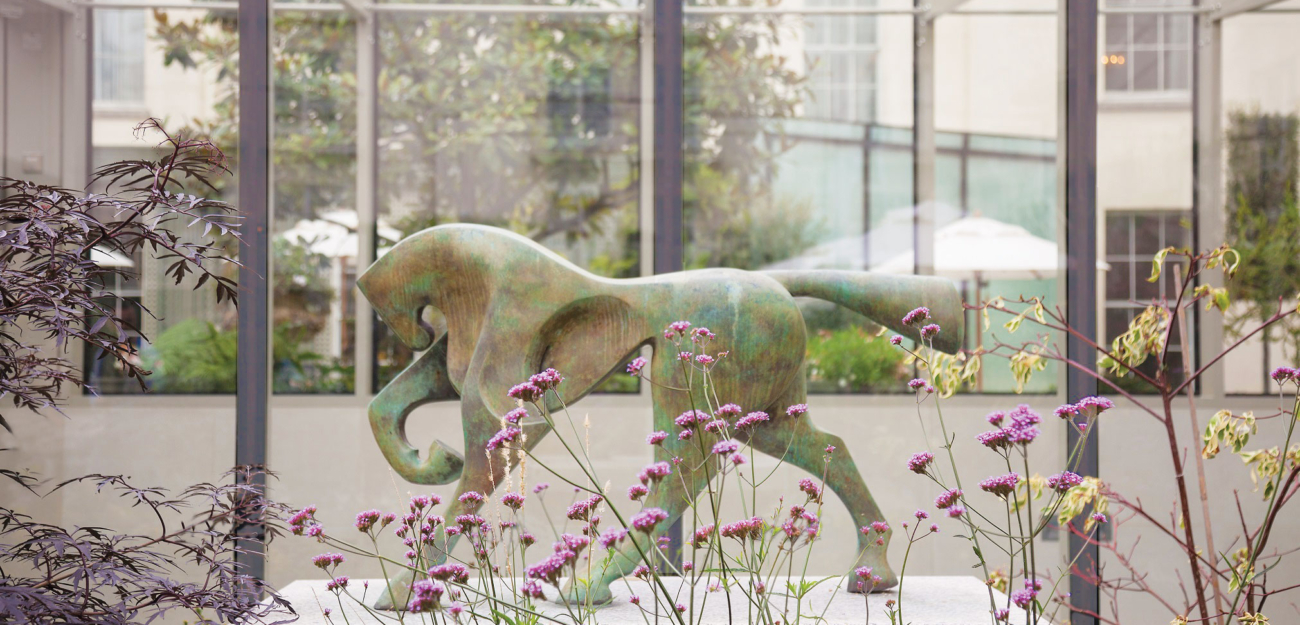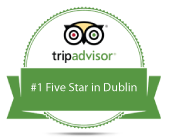The Art of the Horse
The Dublin Horse Show, taking place this August, elevates horse riding to a fine art, but Irish artists are famous for their ways with horses too.
The RDS Horse Show is a focal point of the Irish social calendar. Even those who aren’t glued to the show jumping or showing rings are to be found at the Royal Dublin Society, showing off their finery, meeting old friends and making new ones. A love of horses runs deep in Ireland, with our rich pastures helping to breed, and train some of the greatest horses in the world. No wonder artists have long been inspired.
In the Merrion Hotel, Conor Fallon’s bronze Running Horse sculpture takes pride of place in the lower Garden Room Terrace. “I will draw directly from the horse or the fish, an actual horse or fish, until I can draw a horse or fish with my eyes closed,” the artist once explained. In the Merrion’s sculpture, you can feel the power, and grace of the animal, and its beauty. Like all the best art, Fallon’s horse focuses on the idea it conveys: strength, grace and other-worldly magnificence in this case; rather than aiming to be a faithful replica of a horse.
From the famous cave paintings at Lascaux, dating to around 17,000 BC, horses have galloped through art history. In former eras they were more central to daily life, and while, as with almost everywhere in the world, Ireland has fully embraced engines for travelling, and for farming, this country retains a closer connection with horses than most.
Famous artists, such as the 18th century George Stubbs, and 19th century Alfred Munnings made paintings of horses, which are so real you could almost imagine their subjects trotting off the canvas. Irish artists Peter Curling and Tony O’Connor continue this wonderful tradition. However, two other artists, who both feature in The Merrion’s art collection, Jack Butler Yeats and Mainie Jellett, both created unforgettable works in the same vein as Fallon’s sculpture.
These two painters caught the essence of “horse” in their paintings, although in their cases, you’ll need to take a trip to our near neighbours at the National Gallery of Ireland to see their equine art. See Yeats’s The Singing Horseman here, and find more about Mainie Jellett’s beautiful Achill Horses online here. In 2020, the National Gallery curated Irish Horse, a powerful online exhibition, and you can find the fascinating and fully illustrated catalogue in the National Gallery shop.

Perhaps it’s because of our small size, but Irish people retain their connection with the land, through family ties, or family holidays; and where there’s land in Ireland, horses aren’t too far away. One of the joys of Irish train travel is the opportunity it gives you to peer into back yards and back fields, and it doesn’t take too long on board to realise that this country truly is still the land of the horse.
Fallon himself was born in Dublin in 1939, but grew up in County Wexford. Electing to study natural sciences at Trinity College, he was wisely advised by his tutors to concentrate on his art. He perhaps best embodies that lovely Irish duality of urban and rural sensibilities, and brought his early scientific training to develop his keen observational skills, where they were balanced by the poetry of his vision.
He spent time in the artists’ colony of St Ives in Cornwall with Tony O’Malley, whose work is also in The Merrion’s collection. Both O’Malley and Fallon were known for their warmth, and their wisdom and wit, so one can only imagine the marvellous conversations that must have taken place, long into the evening. It was in St Ives that Fallon met his wife, the artist Nancy Wynne-Jones.
Multi-award winning in his life, Fallon once described an idea in Thoughts on Sculpture, that the problem many artists had with horses was that they saw them essentially as tables – with a leg at each corner – which makes any resulting sculpture static and awkward. Look again at his brilliant bronze Running Horse and see that they are actually all about beauty, power, and contained strength. “I look for what I feel are the essential lines of energy,” he wrote in another note. Discover more by taking the free self-guided Audio Art Tour at The Merrion, and perhaps round off your ideal arty afternoon with The Merrion’s famous Art Afternoon Tea, where the sweet creations are inspired by the wonderful works that surround you.
The Royal Dublin Horse Show takes place from August 9th to 13th 2023. Hotel guests can book tickets through The Merrion Concierge.




